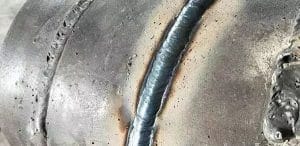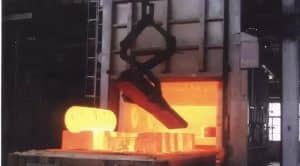Post-weld Heat Treatment is not Entirely Advantageous
Post-weld heat treatment – Welding residual stress is caused by non-uniform temperature distribution, thermal expansion and contraction of weld metal, so it is inevitable to produce residual stress with welding construction.
The most common method to eliminate residual stress is high-temperature tempering, in which the weldments are heated to a certain temperature and held for a certain time in a heat treatment furnace, taking advantage of the reduction of the yield limit of the material at high temperature, when the internal stress is high, the plastic flow will occur, the elastic deformation will decrease, and the plastic deformation will increase and the stress will decrease.
1) Selection of heat treatment methods
The influence of post-weld heat treatment on tensile strength and creep limit of metal is related to the temperature and holding time of heat treatment. The effect of post-weld heat treatment on the impact toughness of weld metal varies with different steel grades. Post-weld heat treatment generally select a single high-temperature tempering or normalizing plus high-temperature tempering treatment. This is because of the welding seam and heat affected zone of coarse grain, the need to refine the grain, so the use of normalizing treatment. However, single normalizing can not eliminate residual stress, so it is necessary to add high temperature tempering to eliminate stress. The single medium temperature tempering is only suitable for the assembly welding of large-scale ordinary low carbon steel vessel assembled on site. Heat treatment of heating and cooling should not be too fast, and strive to uniform internal and external walls.
2) Heat treatment method for pressure vessel
There are two kinds of heat treatment methods used in pressure vessels: one is heat treatment to improve mechanical properties, the other is post-weld heat treatment (PWHT) . Generally speaking, the post-weld heat treatment is the heat treatment to the welding area or the welding component after the workpiece is welded.
It includes stress relief annealing, complete annealing, solid melting, normalizing, normalizing and tempering, tempering, low temperature stress relief, precipitation heat treatment, etc. . In a narrow sense, post-weld heat treatment refers only to the elimination of stress annealing, that is, in order to improve the performance of the welding zone and eliminate harmful effects such as welding residual stress, thus, the welding area and related parts are uniformly and fully heated below the temperature point of metal phase transition 2, and then uniformly cooled. The post-weld heat treatment discussed in many cases is essentially the post-weld stress relief heat treatment.
3) Objective of post-weld heat treatment
1.Relax the welding residual stress.
2.To stabilize the shape and size of the structure and reduce distortion:
- Improve the plasticity of weld metal
- Reduce heat-affected zone hardness
- Improve fracture toughness
- Improve fatigue strength
- Restores or improves the reduced yield strength in cold forming
3.Improve resistance to stress corrosion
4.Further release of harmful gases in the weld metal, especially hydrogen, prevents the occurrence of delayed cracks
4) PWHT judgment of necessity
The necessity of post-weld heat treatment for pressure vessels should be clearly defined in the design, which is required in the current design specifications for pressure vessels.
In the welded pressure vessel, there is a large residual stress in the welding area, and the residual stress has an adverse effect. Only under certain conditions. When the residual stress is combined with hydrogen in the weld, the heat-affected zone (Haz) hardens, leading to cold and delayed cracks.
When the static stress in the weld or the dynamic stress in the load operation is combined with the corrosion action of the medium, it may cause the crack-like corrosion, so-called stress corrosion. The welding residual stress and the base metal hardening caused by welding are the important factors to produce stress corrosion cracking.

The results show that the main effect of deformation and residual stress on metallic materials is to change from uniform corrosion to local corrosion, i. e. Intergranular or transgranular corrosion. Of course, both corrosion cracking and intergranular corrosion of metals occur in media with certain properties for such metals.
In the presence of residual stress, depending on the composition, concentration, and temperature of the erosive medium, as well as the base metal and the welding area of the composition, microstructure, surface state, stress state and other differences, so that the nature of corrosion damage may be changed.

Whether the welded pressure vessel needs post-weld heat treatment or not should be decided from the use of the vessel, the size (especially the thickness of the wall plate), the properties of the materials used and the working conditions.
The post-weld heat treatment shall be considered in any of the following cases:
1.The use of harsh conditions, such as working at low temperature there is a risk of brittle fracture of thick-walled vessels, vessels to bear a larger load and alternating load.
2.Welded pressure vessels of more than a certain thickness. Including boilers, petrochemical pressure vessels and other special regulations, norms.
3.Pressure vessel with high dimensional stability.
4.A vessel made of hardened steel.
5.A pressure vessel in danger of stress corrosion cracking.
6.Other pressure vessels specified in special regulations, specifications and drawings.
5) PWHT integrated effect considerations
Post-weld heat treatment is not absolutely advantageous. In general, post-weld heat treatment is beneficial to alleviate residual stress, and stress corrosion is strictly required to carry out the case. However, the impact toughness test shows that the post-weld heat treatment is disadvantageous to the toughness of the deposited metal and the HAZ, and sometimes intergranular cracking may occur in the grain coarsening range of the Haz.

Therefore, when considering whether to carry out post-weld heat treatment, the advantages and disadvantages of heat treatment should be comprehensively compared. From the point of view of structural performance, there is a side to improve performance, there is a side to reduce performance, should be considered in a comprehensive basis of two aspects of the work to make a reasonable judgment.
Learn more our project quality managemet, QAQC and third party inspection (TPI), NDT practices thru below link.-
https://www.jsc-safe.com/welding-inspector-supervisor-cwi-cswip-iwe-iwi-iws/
